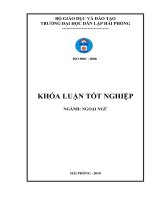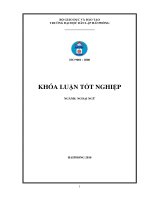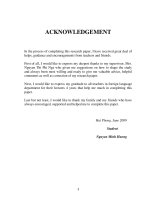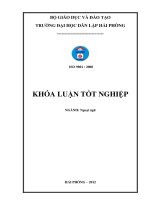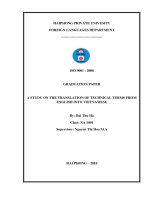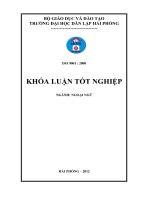A study on translation of economic and trade terminology from english into vietnamese
Bạn đang xem bản rút gọn của tài liệu. Xem và tải ngay bản đầy đủ của tài liệu tại đây (549.78 KB, 69 trang )
BỘ GIÁO DỤC VÀ ĐÀO TẠO
TRƯỜNG ĐẠI HỌC DÂN LẬP HẢI PHÒNG
ISO 9001 : 2008
KHÓA LUẬN TỐT NGHIỆP
NGÀNH: NGOẠI NGỮ
HẢI PHÒNG – 2012
HAIPHONG PRIVATE UNIVERSITY
FOREIGN LANGUAGES DEPARTMENT
GRADUATION PAPER
A STUDY ON TRANSLATION OF
ECONOMIC AND TRADE TERMINOLOGY
FROM ENGLISH INTO VIETNAMESE
By:
Le Thi Ha
Class:
NA1201
Supervisor:
Nguyen Thi Hoa, M.A
HAI PHONG – 2012
BỘ GIÁO DỤC VÀ ĐÀO TẠO
TRƯỜNG ĐẠI HỌC DÂN LẬP HẢI PHÒNG
Nhiệm vụ đề tài tốt nghiệp
Sinh viên: Mã số:
Lớp: …….Ngành:
Tên đề tài:
Nhiệm vụ đề tài
1. Nội dung và các yêu cầu cần giải quyết trong nhiệm vụ đề tài tốt nghiệp
( về lý luận, thực tiễn, các số liệu cần tính toán và các bản vẽ).
……………………………………………………………………………
……………………………………………………………………………
……………………………………………………………………………
……………………………………………………………………………
……………………………………………………………………………
……………………………………………………………………………
……………………………………………………………………………
……………………………………………………………………………
2. Các số liệu cần thiết để thiết kế, tính toán.
………………………………………………………………………………
………………………………………………………………………………
………………………………………………………………………………
…………… …………………………………… …………………………
……………… ……………………………………………………………
…………….…………………………………………………………………
………………….……………………………………………………………
………………………………………………………………………………
……………… ……………………………………………………………
3. Địa điểm thực tập.
………….……………………………………………………………………
………………………………………………………………………………
…… ……………………………………………………… ………………
…………………………………………………………… ……………………
………………………………………………………… ………………………
……………………………………………………… …………………
CÁN BỘ HƯỚNG DẪN ĐỀ TÀI
Người hướng dẫn thứ nhất:
Họ và tên:
Học hàm, học vị:
Cơ quan công tác:
Nội dung hướng dẫn:
Người hướng dẫn thứ hai:
Họ và tên:
Học hàm, học vị:
Cơ quan công tác:
Nội dung hướng dẫn:
Đề tài tốt nghiệp được giao ngày…… tháng …… năm 20……
Yêu cầu phải hoàn thành xong trước ngày…… tháng …… năm 20….
Đã nhận nhiệm vụ ĐTTN Đã giao nhiệm vụ ĐTTN
Sinh viên Người hướng dẫn
Hải Phòng, ngày…. Tháng… năm 20….
HIỆU TRƯỞNG
GS.TS.NGƯT Trần Hữu Nghị
PHẦN NHẬN XÉT TÓM TẮT CỦA CÁN BỘ HƯỚNG DẪN
1. Tinh thần thái độ của sinh viên trong quá trình làm đề tài tốt nghiệp:
……………………………………………………………………………
……………………………………………………………………………
……………………………………………………………………………
……………………………………………………………………………
……………………………………………………………………………
……………………………………………………………………………
……………………………………………………………………………
……………………………………………………………………………
2. Đánh giá chất lượng của khóa luận (so với nội dung yêu cầu đã đề ra trong
nhiệm vụ Đ.T. T.N trên các mặt lý luận, thực tiễn, tính toán giá trị sử dụng,
chất lượng các bản vẽ)
……………………………………………………………………………
……………………………………………………………………………
……………………………………………………………………………
……………………………………………………………………………
……………………………………………………………………………
……………………………………………………………………………
……………………………………………………………………………
……………………………………………………………………………
……………………………………………………………………………
3. Cho điểm của cán bộ hướng dẫn :
(ghi bằng cả số và chữ)
Hải Phòng, ngày … tháng … năm 20…
Cán bộ hướng dẫn
(họ tên và chữ ký)
NHẬN XÉT ĐÁNH GIÁ
CỦA NGƯỜI CHẤM PHẢN BIỆN ĐỀ TÀI TỐT NGHIỆP
1. Đánh giá chất lượng đề tài tốt nghiệp về các mặt thu thập và phân tích tài liệu,
số liệu ban đầu, giá trị lí luận và thực tiễn của đề tài.
2. Cho điểm của người chấm phản biện :
(Điểm ghi bằng số và chữ)
Ngày tháng năm 20…
Người chấm phản biện
ACKNOWLEDGEMENTS
In the process of completing this graduation paper, I have received a
great deal of help, advice, guidance and encouragement from many teachers,
friends and my family. It is my great pleasure I have got.
First of all, I wish to express my deepest gratitude to my supervisor,
Nguyen Thi Hoa, M.A for her constant support, various materials, precious
advice and valuable comments on draft chapters to complete this study. This
would not have been possible without her supports.
Besides, I would like to extend my sincere thanks to Hai Phong Private
University for providing us professional learning environment and facilities as
well as all the teachers in Foreign Language Department for their useful
lessons, teaching, guidance, experience sharing with the kind heart and whole-
hearted instruction and giving enthusiasm, sympathies to lift us to be better ones
as we are today.
Especially, I am proud of my family and friends. They are always beside,
support and encourage me throughout this study. I wishfully send the deepest
gratitude to all of efforts, support for me to complete this graduation paper.
Finally, It is an honor for me to extend my regards to all those who kindly
gave their advice and supported me. If there are not these helps, I could not
complete my graduation paper successfully. All your help and support are
motive power for me to finish this study.
Hai Phong, December 02
nd
2012
Le Thi Ha-NA1201
TABLE OF CONTENTS
ACKNOWLEDGEMENTS
PART I: INTRODUCTION 1
I. Rationale of the study…………………… ………………………….…1
II. Aims of the study………………………… ……………………… 2
III. Scope of the study………………………… …………………………3
IV. Methods of the study………………………… ………………… 4
V. Design of the study…………………………… ………………………4
PART II: DEVELOPMENT 6
CHAPTER I: THEORETICAL BACKGROUND…………… 6
I. Definition of translation……………………………………… ….……6
II. Translation methods………………………………… …….……8
II. 1. Word- for - Word Translation …………………………… ……… 8
II. 2. Literal Translation ………………………………………… ………9
II. 3. Faithful Translation ………………………………………… … 9
II. 4. Semantic Translation ……………………………………… … 10
II. 5. Adaptation ………………………………………………… …… 10
II. 6. Free Translation …………………………………………… … 11
II. 7. Idiomatic Translation……… ……………………………… …….11
II. 8. Communicative translation………………………………… … 11
III. Translation Equivalence ……………………………………… ……12
III. 1. Definition of translation equivalence……………………… …….12
III. 2. Types of equivalence………………………………….…… …….13
IV. English for Specific purposes in translation (ESP) …….…… …….15
IV. 1. Definition of ESP………………………………………… …… 15
IV. 2. Types of ESP…………………………………….……… ………16
V. Terminology and its main characteristics…………………… ………18
V. 1. Definition of terminology………………………………… ….… 18
V. 2. Main characteristics of terminology……………………… ………18
V. 2.1. Accurateness…………………………………………… …… 19
V. 2.2. Systematism………………………………………………… ….19
V. 2.3. Internationalism …………………………………………… … 20
V. 2.4. Nationalism…………………………………………… ……… 21
V. 2.5. Popularity …………………………………………… …… 21
V. 3. The distinction between terms and word……………… …… …22
CHAPTER II: ECONOMIC AND TRADE TERMINOLOGY………….23
I. Definition of Economics and Trade………………………… …….….23
II. Language in economic and trade sector …………………… …….…23
III. The role of terminology in Economic and Trade Translation … 24
IV. Classification of Economic and Trade terminology………… ….….24
IV. 1. Single terminology……………………………………… ……….24
IV. 1.1. Single terminology in form of Noun……………… ………….25
IV. 1.2. Single terminology in form of Verb……………… …… …26
IV. 2. Neologism ………………………………………… ……………27
IV. 2.1. Eponyms………………………………………… ………… 27
IV. 2.2. Acronyms……………………………………… ………… ….28
IV. 3. Compound terminology …………………………… ……………29
IV. 3.1 Terminologies consisting of classifier (noun) + thing …… …29
IV. 3.2. Terminologies consisting of classifier (adjective) + thing … ….30
IV. 3.3. Terminologies consisting of Classifier ( Present participle )
+thing…………………………………………………… …………… 30
IV. 3.4. Terminologies consisting of Classifier ( Past participle )
+thing …………………………………………………… …………… 31
IV.3.5. Terminologies consisting of Classifier (Noun + Present participle) +thing
………………………………………………………… ……… 31
IV. 3.6. Terminologies consisting of thing + Qualifier…… ………… 32
IV. 4. Phrase ……………………………………………… ……………32
IV. 5. Positive terminology ………………………………… ………….33
IV. 6. Negative terminology ……………………………… ………… 34
CHAPTERIII: POPULAR STRATEGIES AND PROCEDURES APPLIED
IN THE TRANSLATION OF ECONOMIC AND TRADE
TERMINOLOGY FROM ENGLISH INTO VIETNAMESE. 35
I. Popular strategies and procedure applied in non-equivalence…… … 35
I. 1. Translation by paraphrase using unrelated word…………… …….35
I. 2.Translation by paraphrase using related word ……………… …38
I.3. Translation by addition………………………………………… … 40
I.4. Translation by using loan word………………………………… ….42
I.5. Translation by omission ……………………………………… … 44
II. Procedures applied in the Equivalence translation……………… … 45
II. 1. Literal translation …………………………………………… ……45
I. 2. Shift or transposition translation…………………………… …… 47
III: Main Findings ……………………………………………… …… 49
PART III: CONCLUSION 52
I. Strength and weakness of thesis……………………………… …… 52
II. Suggestion for the further research and final comments…… ……… 52
REFERENCE 54
APPENDIX
1
PART I: INTRODUCTION
I. Rationale of the study
Nowadays, with the development of our society as well as other
countries in the world, economic and trade sector has become one
indispensables field in the economy in general, development of the countries in
particular, including our Vietnam. Thanks to the open-door policy and the
renovation process, Vietnam is currently a developing country with many
wonderful changes and processes in various fields such as economy, politics,
culture and society, science and technology. The Party, Government and all
Vietnamese are constantly trying the best to make Vietnam rub shoulders with
powerful countries in five continents.
Vietnam is on the way of international economic integration. In detail,
many enterprises, companies, factories have been established. In addition, there
have appeared here many representative offices of foreign companies. We have
established the economic and trade relations with a lot of countries. Successful
2
economic and trade cooperation requires many factors, of which mutual
understanding is the most importance. Therefore, the translation of economic
and trade documents plays an important role and is of the greatest concern.
However, the translation from English into Vietnamese or vice versa is a big
challenge, because of the differences between English and Vietnamese languages
and culture. Especially, in economic and trade field, the translation of its
documents in general and terminology in particular is not a simple task because of
their fully specific terminology.
Moreover, economic and trade cooperation among different countries in
the world is increasing, to become a good translator is not only the interest of
many people but mine. However, I often meet many difficulties as well as
challenges in translation process because of the linguistic differences between
the two language systems and the most noticeable difficulty is the problem of
how to deal with non-equivalence and equivalence economic and trade
terminology.
Therefore, with the hope of helping translators, as well as myself
particularly, students who have just graduated begin to step out the university
environment and have orientation to become future translators in economic and
trade field, I implement this study to study on the translation of economic and
trade terminology from English into Vietnamese. Hopefully, it can help
translators enhance their translation skills after reading.
II. Aims of the study
The study on the translation of basic economic and trade terminology
aims to figure out an overview on translation strategies and procedures which
are commonly employed in translation of economic and trade terminology.
In detail, my Graduation Paper is aimed at:
3
Reviewing the theoretical issues relating to translation, translation
methods, translation equivalence and terminology , its definition and main
characteristics.
Collecting and presenting basic English terminology in economic and
trade sector.
Providing their Vietnamese equivalences or expressions.
Finding out the translation strategies and procedures applied in the
translation of economic and trade terminology from English into Vietnamese.
Providing students major in the subject, translators and those who may
concern a draft and short reference of basis English terminology in economics
and trade and their corresponding Vietnamese meanings.
Hopefully, the study will provide readers overall comprehension about the
information of economic and trade terminology, especially for future translators
who are willing to become good translators in economic and trade field.
III. Scope of the study
Terminology is various in different fields such as commerce and business,
market, economic laws, insurance, investment, shares and securities, etc…
However, it is impossible for me to carry out study on them, due to limitation of
time and my knowledge. In my study and work process, recognizing that
economic and trade terminology plays an important role in Business
Management and Foreign Trade field, especially in the renovation period of our
country. Therefore, the major aspects of the investigation are translation and
popular translation strategies being applied in economic and trade terminology
from English into Vietnamese.
4
IV. Methods of the study
As this study is carried out for the sake of translation of economic and
trade terminologies from English into Vietnamese, the quantitative method is
applied. I have implemented this study with the support sources from economic
and trade books and dictionaries, internet and other references.
Then, from the collected data I will analyze their features to find the
suitable procedures which are used to translate from English into Vietnamese.
V. Design of the study
This study includes three main parts:
The first Part is an Introduction, consist of consist of rationale of the
study, aims of the study, scope of the study, methods of the study and design of
the study.
The second Part is the main part which title Development, being divided
into three chapters:
The first chapter is the theoretical background with definitions of
translation, translation methods, translation Equivalence, main knowledge on
English for Special Purposes (ESP) in translation and terminology along with
the distinction between terms and word.
The second chapter is the chapter which I focus on Economic and Trade
terminology including definition of economics and trade, language in economic
and trade sector, the role of terminology in Economic and trade translation,
together with classification of Economic and Trade terminology.
The third chapter is implication of the study which tittles “popular
strategies and procedures applied in translation of economic and trade
terminology from english into vietnamese”, basic methods applied in non-
5
equivalence and equivalence translation. Then, I denote main findings which I
gained during the time of carrying out this study.
The third Part is the Conclusion including strength, weakness of my
graduation paper and suggestion for further study.
6
PART II: DEVELOPMENT
CHAPTER I: THEORETICAL BACKGROUND
In this section the issues relating to translation theory such as the
definition of translation, translation method, and translation equivalence and
relevant theory including:
I. Definition
Translation, a phenomenon traditionally considered as an “art”, has
existed in every corner of our life. It has been approached from a scientific and
technical point of view and considered as an indispensable part in the field of
not only literature, culture and religion but also commercial advertisement,
popular entertainment, public administration, immigration and
education….especially in this current renovation economy. Thus, definition has
been defined variously. They are defined under many different ways which were
given by a lot of famous translators longtime ago as “Foster, Cartford, Reiss,
Bell, Pinhhuck…and its definition is continuously discovered, definited in many
new ways and began to appeared in books, dictionaries or websites. There have
been a great number of books and articles which have been written about this
subject. The following are some typical definitions which are basic theoretical
background for my study:
Cartford (1965:20) considers as follows:
“Translation is the replacement of text material of this language (source
language) with text material of another (target language)”.
Hartman and Stork (1971:1) believes that :
“Translation is the replacement of a representation of a text in one
language by a representation of an equivalent text in a second language”.
Wilss (1982:3) shares as below:
7
“Translation is a transfer process, which aims at the transformation of a
written SL text into an optimally equivalent TL text, and which requires the
syntactic, the semantic and the pragmatic understanding and analytical
processing of the SL”.
Nida, E.A. (1984:83) claims:
“Translating consists in reproducing in the receptor language that closest
natural equivalent to the message of the source language, first in meaning and
secondly in style”.
Bui Tien Bao, Ha Noi National University has another definition:
“Translation is rendering a written text into another language in a way that
the author intended the text”.
Advanced Oxford Dictionary ( page 1632)defines:
“Translation is the process of changing something that is written or
spoken into another language”.
According to wikipedia , translation is claimed:
“Translation is the interpreting of the meaning of a text and the
subsequent production of an equivalent text, likewise called a translation that
communicates the same message in another language. The text to be translated
is called the source text, and the language that it is to be translated into is called
the target language; the final product is sometimes called the target text.”
It is clear that the above definitions given by different linguists from
different contexts, share common features of emphasizing the importance of
finding closest equivalence in meaning with similar characteristics to the
original by the choice of appropriate target language’s lexical and grammatical
structures. Some sorts of transfer from one language to another also insist on the
different methods of translation which will be taken into consideration in the
next part.
8
II. Translation methods
For learners of English, there are different approaches to translation with
various methods. For a number of definitions of translation given above, we can
see that the understandings of translation varies from one to another. The central
problem of translating is whether to translate literally or freely. It all depends on
some factors such as the purpose of the translation, the nature of readership and
the text types. As stated by Peter Newmark (1988:45) there are eight methods of
translation.
And basing on the degree of emphasis on the SL and TL, he puts it in a
flattened diagram as below:
SL Emphasis
Word-for-word translation
Literal translation
Faithful translation
Semantic translation
TL Emphasis
Adaptation
Free translation
Idiomatic translation
Communicative translation
II. 1. Word- for- word Translation
This is the type of translation that English learners are likely to take up in
the process of mastering their translation skills. In word-for-word translation, the
source language word order is preserved and the words are singly translated by
their most common meanings, out of context. Cultural words are literally
translated. The main use of this method is either to understand the mechanics of
the source language or to construe a difficult text as pre-translation process.
For example:
All worldly things may change with time, but the impression of the first love
will remain a vivid as ever.
(Victor Hugo)
9
Tất cả mọi vật trên thế gian có thể thay đổi với thời gian, nhưng ấn tượng
về mối tình đầu sẽ tồn tại mãi mãi.
(Vương Trung Hiếu, 1993: p.147)
II. 2. Literal translation
This is a broader form of translation, each SL word has a corresponding
TL word, but their primary meaning may differ. The SL grammatical forms are
converted to their nearest target language equivalents. However, the lexical
words are again translated out of context. Literal translation is considered the
basic translation step, both in communication and semantic translation, in that
translation starts from there. As pre-translation process, it indicates problems to
be solved.
For example:
I tried for a moment to see the situation through her eyes.
(Deignan, 1998: p.6)
Tôi đã thử một lần cố nhìn nhận tình huống theo cách nhìn của cô ta.
II.3. Faithful translation
This method tries to reproduce the precise contextual meaning of the
original within the constraint of the TL grammatical structures. It transfers
cultural words and preserves the degree of grammatical and lexical deviation
from SL norms. It attempts to be completely faithful to the intentions and the
text-realization of the SL writer.
For example:
Whoever wants to hurt her shall first go over my corpse.
Đứa nào muốn đụng tới cô ấy thì bước qua xác tao đã.
10
II.4. Semantic translation
Semantic translation differs from faithful translation only in as far as it
must take more account of the aesthetic value of the SL text, compromising on
“meaning” where appropriate so that no assonance, word-play or repetition jars
in finished version. It does not rely on cultural equivalent and makes very small
concession to the readership. While “faithful” translation is dogmatic, semantic
translation more flexible. New Mark (1982:22) says that “…semantic constraints
of the target language, to reproduce the price contextual meaning of the author”.
For example:
One man’s meat is another man’s poinson
Đám cưới nhà ta , đám ma nhà người
II.5. Adaptation
This method is the freest form of translation. It is frequently used for
plays (comedies) and poetry: themes, characters, plots preserved, SL culture
converted to TL culture and text is rewritten. Dung Vu (2004) points out that:
“Adaptation has a property of lending the ideas of the original to creative a new
text used by a new language mare than to be faithful to the original. The creation
in adaptation is completely objective in content as well as form”.
For Example:
Below the bridge runs the current pure and clear
And there the grass grows soft, by the bridge.
Ngồi đầu cầu nước trong như lọc
Đường bên cầu cỏ mọc còn non.
11
II.6. Free translation
Free translation is the translation which is not close to the original, but the
translation just transmits meanings of the SL in her/his own words. It reproduces
the matter without the manner, or the content without the form of the original.
Usually it is a paraphrase much longer than the original. Therefore, the
advantage is that the text in TL sounds more natural. On the contrary, the
disadvantage is that translating is too casual to understand the original because
of its freedom
For Example:
It would rather the victorious brightness in an only moment than the
centenary twinkle.
Thà một phút huy hoàng rồi vụt tắt còn hơn le lói suốt trăm năm.
II.7. Idiomatic translation
Idiomatic translation is concerned with communicating the meaning of the
source text using the natural grammatical and lexical items of the target
language.
Idiomatic translation is used for colloquialism and idioms whose
literalism is the translation by which the translator does not transfer the
literalism of the original, uses the translation of colloquialism and idioms.
For Example:
He carries fire in one hand and water in the other
Vừa ăn cướp vừa la làng
II. 8. Communicative translation
This method attempts to render the exact contextual meaning of the
original in such a way that both content and language are readily acceptable and
comprehensible to the readership.
“…But even here the translator still has to respect and work on the form of the
source language text as the only material basic for his work”
(Peter Newmark, 1982:39)
12
For example:
Thôi thì hết hờn ghen và giận dỗi
Được giận hờn sung sướng biết bao nhiêu.
(Xuân Diệu)
Well, it’s all with jealousies and sulks
What fun to be in the sulk.
(Vương Trung Hiếu, 1993: p.145)
III. Translation equivalence
III.1. Definition of translation equivalence
The dictionary defines equivalence as being the same, similar or
interchangeable with something else. In translation terminologies, equivalence is
a term used to refer to the nature and extent of the relationship between SL and
TL texts or smaller linguistic units.
The problem of equivalence is one of the most important issue in the field
of translating. It is a question of finding suitable counterparts in target language
for expressions in the source language.
According to Vanessa Leonardo “ Equivalence can be said to be the
central issue in the translation although its definition, relevance, and
applicability within the fields of translation theory have caused heated
controversy, and many different theories of the concept of equivalence have
been elaborated within the past fifty years”. Here are some elaborate approaches
to translation equivalences:
Vinay and Darbelnet (1995:342) consider as below:
“Equivalence-oriented translation is a procedure which replicates the
same situation as in the original, whilst using completely different wording”.
13
Wayne Leman (Wordpress.com) shares :
“Translation equivalence exists between forms in a source language and a
target language if their meaning matches. In other words, translation equivalence
should answer the question “What do the speakers of this language actually say
to express the desired meaning?”
III.2. Types of equivalence
There are many kinds of classification, It depends on the translators and
the way of their analysis. The following types are common types of equivalence
and useful for translators:
Nida shares that there are two different types of equivalence which are
formal correspondence and dynamic equivalence. Formal correspondence
“focuses attention on the message itself, in both form and content”, while
dynamic equivalence is based upon “the principle of equivalent effect”.
Formal correspondence consists of a TL item which represents the
closest equivalent of a SL word or phrase and is not always formal equivalents
between language pairs. Therefore, these formal equivalents should be used
wherever possible if the translation aims at achieving formal rather than
dynamic equivalence. However, the uses of formal equivalents in the translation
will lead the target audience uneasily to understand and might at times have
serious implications in the TT. Nida and Taber share that “Typically, formal
correspondence distorts the grammatical and stylistic patterns of the receptor
language, and hence distorts the message, so as to cause the receptor to
misunderstand or to labor unduly hard” (ibid:201,).
Dynamic equivalence is defined as a translation principle according to
which a translator seeks to translate the meaning of the origin in such a way that
the TL wording will trigger the same impact on the TC audience as the original
wording did upon the ST audience. Nida and Taber (1982:200) argue that
14
“Frequently, the form of the original text is changed; but as long as the change
follows the rules of back transformation in the SL, of contextual consistency in
the transfer, and of transformation in the receptor language, the message is
preserved and the translation is faithful”.
According to Newmark, the purpose of translation is to achieve
equivalence effect which produces the same effects on the readership which
obtained in original. He sees equivalence effect as the desirable result rather
than the aim of any translation except for two cases: (a) If the purpose of the SL
text is to affect and the TL translation is to inform or vice versa; (b) If there is a
pronounced cultural gap between the SL and the TL text.
However, Koller (1979) considers five types of equivalence:
1. Denotative equivalence:
The source language and the target language words refer to the same thing
in real world. It is an equivalence of the extra linguistic content of a text.
2. Connotative equivalence:
This type of equivalence provides additional values besides denotative
value and is achieved by the translator’s choice of synonymous words or
expressions.
3. Text-normative equivalence:
The source language and the target language words are used in the same
or similar context in their respective languages.
4. Pragmatic equivalence:
With readership orientation, the source language and the target language
words have same effect on their respective readers.


